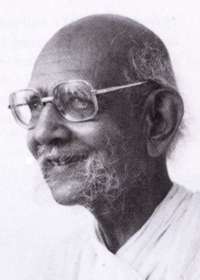Jambuvijaya
Jambuvijaya (1923–2009), also known as Muni Jambuvijayji Maharajsaheb, was a monk belonging to the Tapa Gaccha order of Svetambara sect of Jainism. He was known for his pioneering work in research, cataloguing and translations of Jain Agamas and ancient texts. He was responsible for discovering and publishing many ancient Jains texts lying in different forgotten Jain jnana bhandaras (ancient Jain libraries). He was a disciple of Muni Punyavijay. Both Muni Punyavijay and Jambuvijay worked all their life in the compilation and publication of ancient Jain Agama literature and cataloguing ancient Jain jnana bhandaras. Muni Jambuvijay was a scholar who devoted his entire life to critically editing Jain scriptures.
Muni Jambuvijaya | |
|---|---|
 | |
| Official name | Muni Jambuvijaya Maharaj |
| Personal | |
| Born | Chunilal Bhogilal Joitram 1923 Mandal, Gujarat |
| Died | 12 November 2009 |
| Cremation place | Shankheshvar |
| Religion | Jainism |
| Parents | Bhogilal Mohanlal Joitram, Aniben Popatlal |
| Religious career | |
| Initiation | Jambuvijaya 1937 Ratlam by Acharya Bhuvanvijaya |
Early life and family
Jambuvijaya was born as Chunilal Bhogilal Joitram in 1923 in town of Mandal, Gujarat. His father's name was Bhogilal Mohanlal Joitram (1895–1959) and his mother's name was Aniben Popatlal (1894–1995). He was born in a deeply religious family. His father took vow of lifelong celibacy in 1925 and was initiated as a Jain monk Muni Bhuvanvijaya in 1932. His mother took initiation as Sadhavi Manoharashriji in 1939 under her own sister Sadhavi Labhashriji. All of Jambuvijayaji's aunts were initiated as sadhavi's and there were a number of initiations in his mother's family.[1]
Monkhood
In Ratlam in 1937, at the age of 14 he took initiation as a Jain monk under his father, Acarya Bhuvanvijaya, who became his teacher. Later on he studied under Acarya Punyavijaya and assisted him cataloguing various Jain manuscripts. After the death of Muni Punyavijaya, he became the chief editor of the Jain Agama series.[2] Muni Jambuvijayji was a polyglot and knew 16 languages. Among them were Sanskrit, Prakrit, Pali, Apabhramsha, Gujarati, Hindi, Tibetan and some others.[3]
Revival of ancient scriptures
Prof. Dr. John Cort mentions the difficulties faced and the persistence shown by Muni Jambuvijay in ensuring that ancient manuscripts which were under lock and key were brought to light. Many bhandaras like the one at Patan were unopened for decades or centuries and Muni Jambuvijay had to often use his mendicant charisma to convince the trustee to open up the libraries.[4]
Agama research and editing
List of Books critically edited by Muni Punyavijayji and successor Muni Jambuvijayji:
- Viyah pannati suttam Part-1
- Viyah pannati suttam Part-2
- Viyah pannati suttam Part-3
- Nayadhamma kahao
- Suyagdang sutra
- Dasveyaliya suttam, Uttarjzhayanaim, Avassay suttam
- Sthananga Sutra Part-1
- Sthananga Sutra Part-2
- Sthananga Sutra Part-3
- Painnay Suttai Part-1
- Painnay Suttai Part-2
- Painnay Suttai Part-3
- Nandisutt And Anuogddaraim
- Pannavana Suttam Part-1
- Pannavana Suttam Part-2
- Anuyogdwar sutra Part-1
- Anuyogdwar sutra Part-2
- Dwadsharam Naychakram Part-1
- Dwadsharam Naychakram Part-2
- Dwadsharam Naychakram Part-3
- Panch sutrakam with Tika
- Aendra Stuti Chaturvinshika Sah Swo Vivran
- Siddhahem sabdanushasana Sah swopagya (San) Laghuvrutti
- Mahapacchakkhan Painniyam
- Divsagar pannatti Painnayam
- Tandulveyaliya Painnayam
- Samavayanga Sutra
- Stree Nirvan Kevalibhukti Prakarane
- Surimantra Kalp Samucchaya
- Thanangsuttam and Samvayangsuttam Part-3
- Ayarang suttam (Acaranga Sutra)
- Mahanisiha Suya Khandham
- Nandisuttam
- Dasakalia suttam
- Sutrakrutang sutra Vol-1
- Hastalikhit Granthsuchi Part-1
- Hastalikhit Granthsuchi Part-2
- Hastalikhit Granthsuchi Part-3
Death
Jambuvijay died in a road accident on 12 November 2009 at the age of 87 years. Early morning, he was travelling by foot along with other monks from Balotra to Jaisalmer when they were hit by a truck. He along with Namaskarvijay died in the accident and others are seriously injured.[5] They were cremated at Shankheshvar on Sami Road in Patan.[3] The deaths of Jain ascetics in road accidents while travelling barefoot, resulted in widespread protests by Jains and they demanded for an investigation.[6]
References
- Wiley, Kristi (2006). The A to Z of Jainism. Delhi: Vision Books (originally published by Scarecrow Press). ISBN 81-7094-690-5. OCLC 422763446. p. 105
- Wiley, Kristi (2006) p. 105
- "Jain monks cremated". The Times of India. 13 November 2009. Retrieved 20 November 2009.
- Cort, John (January–March 1995). "The Jain Knowledge Warehouses: Traditional Libraries in India". Journal of the American Oriental Society. American Oriental Society. 115 (1): 77–87. doi:10.2307/605310. JSTOR 605310.
- "Jain Muni Jambuvijayji dies in road accident". Gujarat Global News Network. 3 November 2009. Retrieved 20 November 2009.
- "CID to probe controversial deaths of Jain monks". Daily News and Analysis. 15 November 2009. Retrieved 20 November 2009.